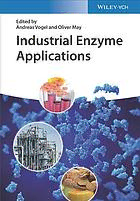
INDUSTRIAL ENZYME APPLICATIONS PDF
Preview INDUSTRIAL ENZYME APPLICATIONS
IndustrialEnzymeApplications Industrial Enzyme Applications Editedby AndreasVogelandOliverMay Editors AllbookspublishedbyWiley-VCH arecarefullyproduced.Nevertheless, Dr.AndreasVogel authors,editors,andpublisherdonot c-LEctaGmbH warranttheinformationcontainedin R&DEnzymeDevelopment thesebooks,includingthisbook,to Perlickstr.5 befreeoferrors.Readersareadvised 04103Leipzig tokeepinmindthatstatements,data, Germany illustrations,proceduraldetailsorother itemsmayinadvertentlybeinaccurate. Dr.OliverMay DSMNutritionalProductsLtd LibraryofCongressCardNo.: Wurmisweg576 appliedfor 4303Kaiseraugst Switzerland BritishLibraryCataloguing-in-Publication Data Acataloguerecordforthisbookis availablefromtheBritishLibrary. Bibliographicinformationpublishedby theDeutscheNationalbibliothek TheDeutscheNationalbibliotheklists thispublicationintheDeutsche Nationalbibliografie;detailed bibliographicdataareavailableonthe Internetat<http://dnb.d-nb.de>. ©2019Wiley-VCHVerlagGmbH& Co.KGaA,Boschstr.12,69469 Weinheim,Germany Allrightsreserved(includingthoseof translationintootherlanguages).No partofthisbookmaybereproducedin anyform–byphotoprinting, microfilm,oranyothermeans–nor transmittedortranslatedintoa machinelanguagewithoutwritten permissionfromthepublishers. Registerednames,trademarks,etc.used inthisbook,evenwhennotspecifically markedassuch,arenottobe consideredunprotectedbylaw. PrintISBN:978-3-527-34385-0 ePDFISBN:978-3-527-81375-9 ePubISBN:978-3-527-81377-3 oBookISBN:978-3-527-81378-0 CoverDesign Adam-Design, Weinheim,Germany Typesetting SPiGlobal,Chennai,India PrintingandBinding Printedonacid-freepaper 10 9 8 7 6 5 4 3 2 1 v Contents Preface xiii PartI OverviewofIndustrialEnzymeApplicationsandKey Technologies 1 1.1 IndustrialEnzymeApplications–OverviewandHistoric Perspective 3 OliverMay 1.1.1 PrehistoricApplications 3 1.1.2 GrowingtheScientificBasis 5 1.1.3 TheBeginningofIndustrialApplicationsandtheEmergingEnzyme Industry 12 References 21 1.2 EnzymeDevelopmentTechnologies 25 AndreasVogel 1.2.1 Introduction 25 1.2.2 IdentificationofWild-TypeEnzymes 26 1.2.2.1 SelectionParametersforStartingEnzymes 28 1.2.3 EnzymeEngineering 30 1.2.3.1 TypesofEnzymeModifications 30 1.2.3.2 GeneralEngineeringStrategies.LibraryDesignandGeneration 30 1.2.3.3 ScreeningforBetterEnzymes 37 1.2.4 ImpactofEnzymeDevelopmentTechnologiesTodayand Tomorrow 38 Acknowledgments 41 References 41 1.3 EukaryoticExpressionSystemsforIndustrialEnzymes 47 LukasRieder,NicoTeuschler,KatharinaEbner,andAntonGlieder 1.3.1 EukaryoticEnzymeProductionSystems 47 1.3.2 SpecialConsiderationsforWorkingwithEukaryoticExpression Systems 47 vi Contents 1.3.2.1 ChoiceofExpressionHost 47 1.3.2.2 ComparisonofCellStructureandTheirInfluenceonMolecular Biology 49 1.3.3 DifferencesinVectorDesignforEukaryoticandProkaryoticHosts 51 1.3.4 DifferencesinRegulationofGeneExpressioninEukaryotesand Prokaryotes 56 1.3.4.1 DifferentTypesofPromoters 58 1.3.5 IndustrialEnzymeProduction 58 1.3.6 EnzymeProductiononIndustrialScale 61 1.3.6.1 HomologousProteinProduction 61 1.3.6.2 HeterologousProteinProduction 62 References 63 1.4 ProcessConsiderationsfortheApplicationofEnzymes 71 SelinKaraandAndreasLiese 1.4.1 BiocatalystTypesUsedinIndustrialProcesses 71 1.4.2 EnzymeImmobilizationforBiocatalyticProcesses 74 1.4.3 ReactionMediumAppliedinEnzymaticCatalysis 76 1.4.3.1 MonophasicSystems–OrganicMedia 77 1.4.3.2 MultiphasicSystems–Liquid/LiquidMixtures 80 1.4.3.3 MultiphasicSystems–Gas/LiquidMixtures 83 1.4.3.4 MultiphasicSystems–Solid/LiquidMixtures 84 1.4.4 AppropriateReactorTypesinEnzymeCatalysis 87 1.4.5 AssessmentCriteriaforEnzymaticApplications 90 References 92 PartII EnzymeApplicationsfortheFoodIndustry 95 2.1 EnzymesUsedinBaking 97 JokeA.PutseysandMargotE.F.Schooneveld-Bergmans 2.1.1 Introduction 97 2.1.2 TheBakingProcess–TheBaker’sNeeds 98 2.1.2.1 FlourQualityandStandardization 98 2.1.2.2 MixingandDoughHandling 100 2.1.2.3 FermentationandDoughStability 105 2.1.2.4 BakingandOvenSpring 109 2.1.3 TheBreadQuality–TheConsumers’Needs 111 2.1.3.1 ColorandFlavor 111 2.1.3.2 ShelfLife 112 2.1.4 TrendsandOpportunitiesforBakingEnzymes 116 2.1.4.1 FineBakingandConfectionary 116 2.1.4.2 ConsumerPreference:Health,IndividualValues,and Convenience 117 2.1.5 Conclusion 118 References 119 Contents vii 2.2 ProteinModificationtoMeettheDemandsoftheFood Industry 125 AndrewEllis 2.2.1 FoodProteins 125 2.2.2 ProcessingofFoodProtein 127 2.2.3 EnzymesintheProcessingofFoodProteins 127 2.2.4 FoodProteinValueChain 130 2.2.5 RecentEnzymeDevelopments 131 2.2.5.1 SimpleProteinModification(ValueLevel3) 131 2.2.5.1.1 DevelopingMicrobialAlternativestoPlantandAnimalEnzymes 131 2.2.5.2 SpecializedEnzymeModification(ValueLevel4) 134 2.2.5.2.1 WheyProteinHydrolysates 134 2.2.5.2.2 PlantProteinHydrolysates 134 2.2.5.3 HighlySpecificProteinModification(ValueLevel5) 135 2.2.5.3.1 GlutenModification 135 2.2.5.3.2 AcrylamideReduction 135 2.2.5.3.3 BioactivePeptides 136 2.2.6 EnzymestoMeetFutureNeeds 137 Acknowledgments 139 References 139 2.3 DairyEnzymes 143 PeterDekker 2.3.1 Introduction 143 2.3.2 Coagulants 145 2.3.2.1 TraditionalRennets 147 2.3.2.2 MicrobialRennets 148 2.3.2.3 FermentationProducedChymosin 151 2.3.3 RipeningEnzymes 152 2.3.3.1 Proteases/Peptidases 153 2.3.3.2 Lipases/Esterases 154 2.3.4 Lactases 154 2.3.4.1 NeutralLactase 156 2.3.4.2 AcidLactase 158 2.3.4.3 GOSProduction 158 2.3.5 MiscellaneousEnzymes 161 2.3.5.1 Oxidases/Peroxidases 161 2.3.5.2 Phopholipases 162 2.3.5.3 Cross-linkingEnzymes 162 2.3.5.4 Preservation 163 2.3.6 NewDevelopments 163 References 163 viii Contents 2.4 EnzymaticProcessfortheSynthesisofCellobiose 167 BirgitBrucherandThomasHäßler 2.4.1 EnzymaticSynthesisofCellobiose 167 2.4.2 Cellobiose–PropertiesandApplications 168 2.4.3 ExistingRoutesforCellobioseSynthesis 170 2.4.4 EnzymeDevelopment 171 2.4.5 ProcessDevelopment 173 2.4.5.1 SynthesisofCellobiose 174 2.4.5.2 PurificationofCellobiose 174 2.4.6 SummaryandFuturePerspective 176 References 176 2.5 EmergingField–SynthesisofComplexCarbohydrates.Case StudyonHMOs 179 DoraMolnar-Gabor,MarkusJ.Hederos,SebastianBartsch,andAndreasVogel 2.5.1 IntroductiontoHumanMilkOligosaccharides(HMOs) 179 2.5.1.1 DiscoveryandFunctionofHMOs 179 2.5.1.2 StructureofHMOs 180 2.5.1.3 HMOProduction,RegulatoryAuthorizations,andCommercial Launch–HistoricalOverview 181 2.5.2 GlycomA/STechnologiesTowardCommercialHMO Production 184 2.5.2.1 WholeCellMicrobialFermentationtoHMOs(InVivoProcess) 185 2.5.2.2 TheGlycomInVitroConcepttoDiversifyHMOBlends 187 2.5.2.3 ValidationoftheHMODiversificationConceptwithNon-optimized Enzymes 187 2.5.3 EnzymeDevelopment 189 2.5.3.1 Optimizationoftheα1-3/4Transfucosidase 189 2.5.3.2 Optimizationoftheα2-6Transsialidase 192 2.5.4 ApplicationsoftheOptimizedEnzymesfortheHMOProfiles 195 2.5.4.1 Scale-UpoftheLacto-N-fucopentaoseIII(LNFP-III),Sialyl Lacto-N-neotetraose(LST-c),andSialylLacto-N-tetraose(LST-a) HMOProfiles 195 2.5.5 ConclusionandPerspective 197 References 198 PartIII EnzymeApplicationsforHumanandAnimal Nutrition 203 3.1 EnzymesforHumanNutritionandHealth 205 YoshihikoHirose 3.1.1 Introduction 205 3.1.2 CurrentProblemsofEnzymesinHealthcareBusiness 205 3.1.3 EnzymesinExistingHealthcareProducts 206 3.1.3.1 DigestiveEnzymes 206
